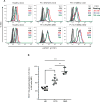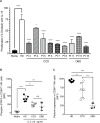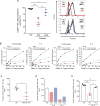Ruxolitinib partially reverses functional natural killer cell deficiency in patients with signal transducer and activator of transcription 1 (STAT1) gain-of-function mutations
- PMID: 29111217
- PMCID: PMC5924437
- DOI: 10.1016/j.jaci.2017.08.040
Ruxolitinib partially reverses functional natural killer cell deficiency in patients with signal transducer and activator of transcription 1 (STAT1) gain-of-function mutations
Abstract
Background: Natural killer (NK) cells are critical innate effector cells whose development is dependent on the Janus kinase-signal transducer and activator of transcription (STAT) pathway. NK cell deficiency can result in severe or refractory viral infections. Patients with STAT1 gain-of-function (GOF) mutations have increased viral susceptibility.
Objective: We sought to investigate NK cell function in patients with STAT1 GOF mutations.
Methods: NK cell phenotype and function were determined in 16 patients with STAT1 GOF mutations. NK cell lines expressing patients' mutations were generated with clustered regularly interspaced short palindromic repeats (CRISPR-Cas9)-mediated gene editing. NK cells from patients with STAT1 GOF mutations were treated in vitro with ruxolitinib.
Results: Peripheral blood NK cells from patients with STAT1 GOF mutations had impaired terminal maturation. Specifically, patients with STAT1 GOF mutations have immature CD56dim NK cells with decreased expression of CD16, perforin, CD57, and impaired cytolytic function. STAT1 phosphorylation was increased, but STAT5 was aberrantly phosphorylated in response to IL-2 stimulation. Upstream inhibition of STAT1 signaling with the small-molecule Janus kinase 1/2 inhibitor ruxolitinib in vitro and in vivo restored perforin expression in CD56dim NK cells and partially restored NK cell cytotoxic function.
Conclusions: Properly regulated STAT1 signaling is critical for NK cell maturation and function. Modulation of increased STAT1 phosphorylation with ruxolitinib is an important option for therapeutic intervention in patients with STAT1 GOF mutations.
Keywords: Janus kinase inhibition; Signal transducer and activator of transcription 1, gain of function; natural killer cell deficiency; natural killer cell maturation; perforin; ruxolitinib.
Copyright © 2017 American Academy of Allergy, Asthma & Immunology. All rights reserved.
Conflict of interest statement
The authors declare no conflict of interest
Figures






References
-
- Cooper MA, Fehniger TA, Caligiuri MA. The biology of human natural killer-cell subsets. Trends Immunol. 2001;22:633–40. - PubMed
-
- Biron CA, Nguyen KB, Pien GC, Cousens LP, Salazar-Mather TP. Natural killer cells in antiviral defense: function and regulation by innate cytokines. Annu Rev Immunol. 1999;17:189–220. - PubMed
-
- Cooper MA, Fehniger TA, Turner SC, Chen KS, Ghaheri BA, Ghayur T, et al. Human natural killer cells: a unique innate immunoregulatory role for the CD56(bright) subset. Blood. 2001;97:3146–51. - PubMed
Publication types
MeSH terms
Substances
Grants and funding
LinkOut - more resources
Full Text Sources
Other Literature Sources
Research Materials
Miscellaneous

